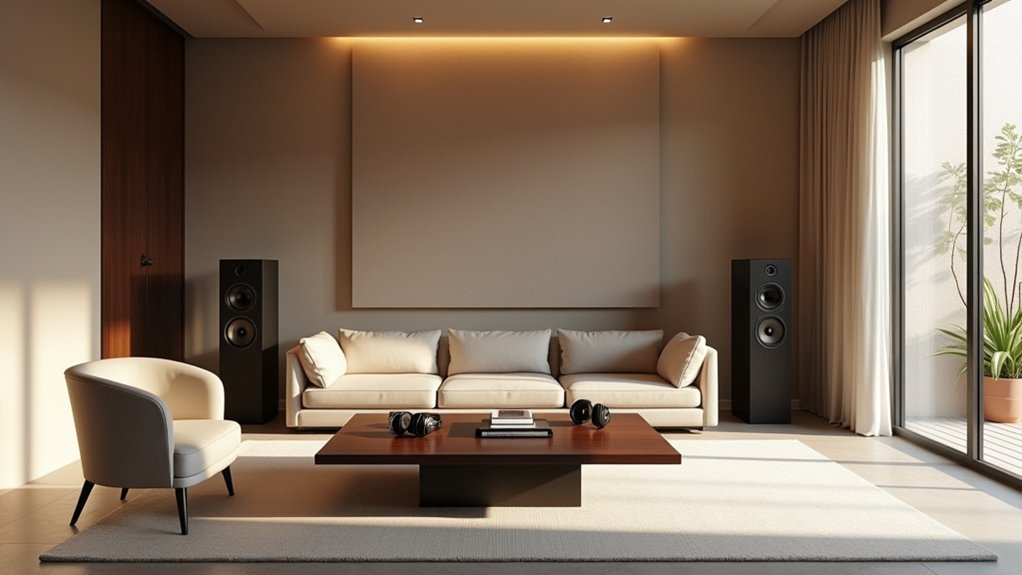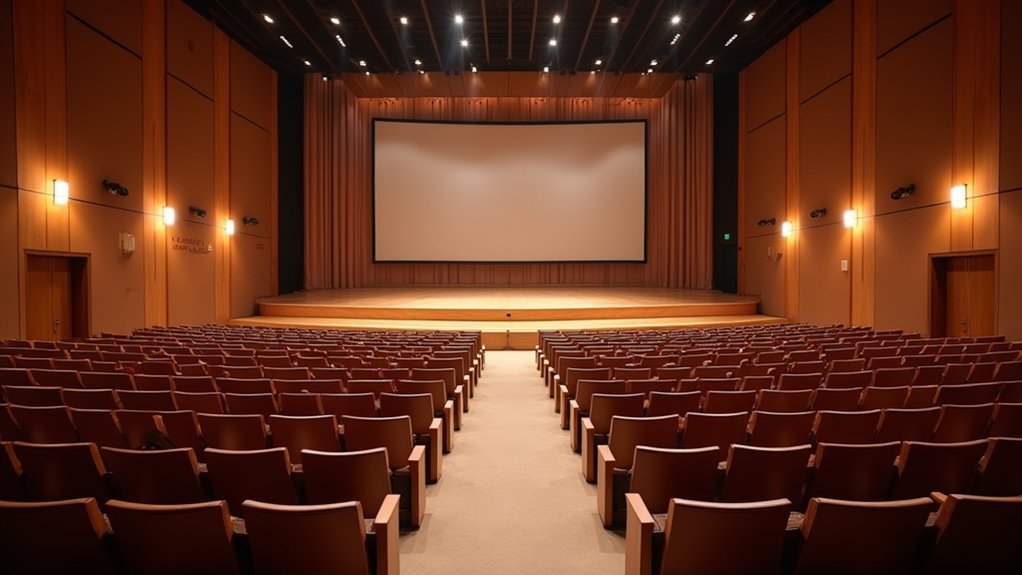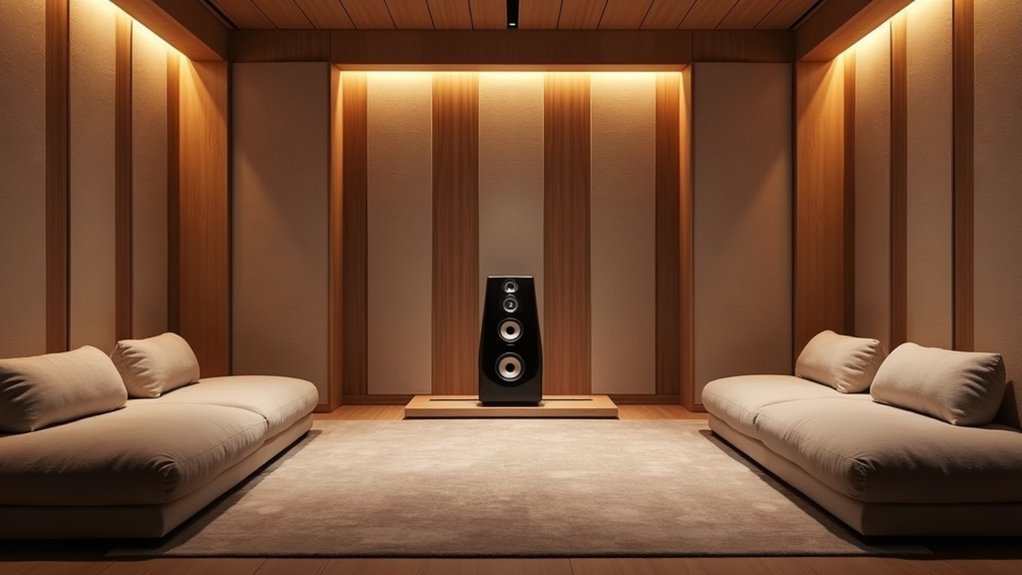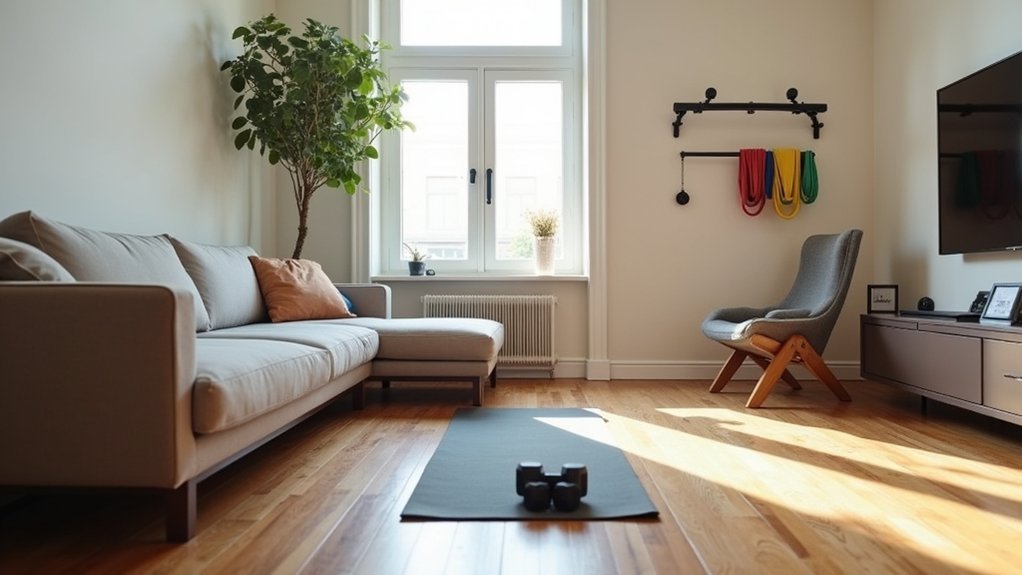You’ll perfect spatial room acoustics by implementing wave field synthesis with dense loudspeaker arrays that recreate natural 3D sound waves. Position speakers within 3 dB of each other for ideal precedence effects, maintain half-wavelength spacing for subwoofers, and use digital signal processing for real-time frequency correction. Keep ambient noise below 30 dBA while targeting 0.5-2.0 second reverberation times for speech applications. These foundational techniques reveal advanced calibration methods that’ll transform your space into a truly immersive reality environment.
Understanding Wave Field Synthesis for Immersive Audio

Wave Field Synthesis transforms how you experience spatial audio by recreating the precise sound waves that would naturally occur from virtual sources positioned anywhere in three-dimensional space.
You’ll benefit from this immersive audio rendering technique’s ability to simulate sound fields from countless virtual sources, making you perceive audio originating from specific spatial locations.
The system uses dense loudspeaker arrays to generate continuous wavefronts, maintaining the binaural precedence effect that’s essential for authentic three-dimensional audio perception.
You can adapt the loudspeaker geometry to suit various environments and applications. The joint time/level algorithm guarantees accurate localization and spatial coherence across your listening position.
For best results, you’ll need careful calibration and strategic speaker placement, with at least two loudspeakers positioned within 3 dB of each other.
Loudspeaker Layout Optimization in 2D and 3D Arrangements
When you’re designing loudspeaker layouts for spatial audio systems, you’ll need to carefully balance coverage patterns, density distribution, and geometric constraints to attain ideal localization across both 2D and 3D configurations.
| Layout Type | Speaker Spacing | Coverage Area |
|---|---|---|
| 2D Horizontal | Even distribution | 360° azimuth |
| 3D Spherical | Adaptive geometry | Full hemisphere |
| Sparse Array | Strategic positioning | Central focus |
Position at least two loudspeakers within 3 dB of each other to leverage binaural precedence effects. You’ll want to maintain front-to-back coverage with +/-2 dB variation across your audience area. Sparse configurations enhance localization by focusing sound within central listening zones. For consistent panning, treat evenly spaced line arrays as single rendering targets. This loudspeaker layout optimization approach guarantees coherent audio delivery while preventing localization discrepancies throughout your immersive environment.
Binaural Precedence Effect and Low-Density Speaker Systems

Building upon these strategic positioning principles, the binaural precedence effect becomes your primary tool for achieving precise localization in low-density speaker configurations.
You’ll maximize spatial accuracy by ensuring at least two loudspeakers remain within 3 dB of each other for each listener position. This proximity requirement allows your brain’s natural processing to center sound localization effectively.
You can leverage sparse loudspeaker layouts to enhance audience perception while maintaining immersive quality.
Joint time/level algorithms will optimize your speaker placement and output levels, creating coherent sound fields across the listening area.
Strategic time and level optimization algorithms precisely calibrate speaker networks, ensuring uniform sound field coherence throughout your designated listening environment.
When you properly implement the binaural precedence effect in low-density systems, you’ll deliver engaging spatial experiences without requiring extensive hardware arrays.
This approach reduces complexity while preserving the integrity of your immersive audio environment.
Object-Based Mixing Parameters for Live Performance
Since object-based mixing treats individual sound elements as discrete entities in three-dimensional space, you’ll gain unprecedented control over live performance audio positioning and movement.
This flexibility transforms how you approach spatial rendering, allowing dynamic repositioning of instruments and vocals throughout your performance.
You’ll want to configure zoom control above 50% to maintain consistent mix levels across different seating areas, ensuring every audience member experiences balanced audio.
Delay parameters become critical for optimizing the precedence effect, minimizing perceived lag for cohesive sound delivery.
Consider integrating active acoustics techniques that dynamically adjust your sound environment based on audience size and requirements.
The Fulcrum One system provides a robust framework for achieving this balance across various live contexts, making object-based mixing both practical and effective.
Front Loudspeaker System Coverage Requirements

Object-based mixing’s spatial precision demands equally precise loudspeaker positioning to deliver its full potential.
Your front loudspeaker system requires meticulous coverage planning to achieve immersive audio excellence. You’ll need at least two loudspeakers within 3 dB of each other for consistent lateral coverage and ideal audio localization.
Key coverage requirements include:
- Even spacing – Position loudspeakers evenly across your stage width to enable coherent sound panning and superior audio quality.
- Tight tolerance – Maintain +/-2 dB coverage variation across your entire audience area for even sound distribution.
- Delay integration – Extend coverage to furthest seats using delay loudspeakers while preserving the +/-2 dB variation standard.
You should confirm your front system covers up to the -3 dB contour of delay elements, creating smooth audio changes that enhance the overall immersive experience.
Delay Speaker Integration and Transition Management
When you’ve established your front loudspeaker coverage, delay speaker integration becomes critical for maintaining audio coherence across extended venue distances.
You’ll need to guarantee at least two loudspeakers operate within 3 dB of each other for effective lateral coverage and smooth audio shifts. Your front system must cover the -3 dB contour of delay elements to maintain consistent sound throughout the audience area.
You can achieve ideal coverage by strategically placing delay loudspeakers in low-profile configurations, particularly for challenging seating arrangements like over- and under-balcony areas.
Configure your delay parameters carefully to fine-tune the precedence effect, which enhances perceived spatiality and clarity.
Maintain consistent sound levels with variations no greater than +/-2 dB across your entire audience to guarantee professional audio quality.
Active Bass Control Below 120 Hz
Active bass control below 120 Hz requires precise management of low-frequency energy that naturally accumulates at room boundaries and creates uneven sound distribution throughout your venue.
Your immersive system depends on strategic subwoofer placement at corners and wall-ceiling joints to maximize coverage and support object-based mixing effectively.
You’ll need to calibrate each subwoofer individually, creating custom signals that target high-pressure zones within your space. This approach optimizes sound pressure distribution for your audience’s benefit.
Essential spacing requirements include:
- Average 1/2-wavelength spacing at the highest frequency you’re addressing, with maximum spacing never exceeding 1 wavelength apart
- Wall spacing limitations of no more than 22 feet for end-to-end wavefronts to maintain proper acoustical coherence
- Additional active bass zones when raised seating alters acoustical impedance throughout your venue
Subwoofer Placement at Room Boundaries
You’ll achieve ideal low-frequency control by positioning your subwoofers at strategic boundary locations where walls meet floors or ceilings.
Corner placement maximizes the pressure zone benefits while minimizing problematic bass build-up that occurs in room centers.
Your spacing between units must follow wavelength principles—averaging 1/2 wavelength at your highest target frequency and never exceeding one full wavelength to maintain coherent sound distribution.
Boundary Pressure Zone Control
Since room boundaries create natural pressure zones that can either enhance or muddy your low-frequency response, you’ll need to position subwoofers strategically at these critical locations.
Effective boundary pressure zone control in audio applications requires precise placement at corners and wall-to-ceiling joints where room acoustics naturally amplify bass frequencies.
Your subwoofer network should follow these spacing guidelines:
- Half-wavelength spacing – Average 1/2-wavelength distance between units at your highest target frequency for ideal pressure distribution
- Maximum wavelength limit – Keep spacing under 1 wavelength apart to prevent phase cancellation and maintain coherent response
- Wall spacing constraint – Maintain no more than 22 ft end-to-end spacing to avoid detrimental low-frequency interactions
You can implement active bass control techniques that generate custom signals for each subwoofer, specifically targeting boundary pressure zones for enhanced audience experience.
Corner and Wall Positioning
When you’re positioning subwoofers at room boundaries, corner placement delivers the most significant acoustic advantage by naturally coupling with the room’s pressure zones. Wall positioning along ceiling joints maximizes your low-frequency coverage below 120 Hz while minimizing boundary build-up issues.
| Placement Location | Maximum Spacing | Frequency Range |
|---|---|---|
| Corner positions | 1 wavelength | Below 120 Hz |
| Wall-ceiling joints | 22 ft maximum | 20-200 Hz |
| Wall boundaries | 1 wavelength | 30-150 Hz |
You’ll achieve coherent end-to-end wavefronts by maintaining proper wall spacing limits. Corner placement naturally amplifies bass response through boundary coupling, while strategic wall positioning targets high-pressure zones throughout your room. This approach guarantees balanced coverage for all listening positions while optimizing your subwoofer array’s overall performance.
Wavelength Spacing Requirements
While proper boundary placement establishes your foundation, wavelength spacing determines how effectively your subwoofer array distributes low-frequency energy throughout the room.
Understanding wavelength spacing requirements guarantees you’ll avoid phase cancellation and maintain consistent sound pressure levels across your listening area.
When configuring your subwoofer spacing, follow these critical guidelines:
- Average 1/2-wavelength spacing at the highest frequency your subwoofers address to guarantee effective sound distribution.
- Never exceed 1 wavelength spacing between units, as wider gaps create phase cancellation and uneven coverage.
- Maintain maximum 22-foot wall spacing for end-to-end wavefronts to prevent detrimental acoustical effects.
These wavelength spacing requirements work in tandem with boundary placement to create seamless low-frequency coverage that enhances your immersive audio experience.
Natural Reverberation Time Optimization
You’ll need to match your reverberation time to your content type, targeting 0.5-2.0 seconds for speech and 1.5-3.0 seconds for music to maximize clarity and presence.
Your room’s natural acoustics can be enhanced through strategic placement of absorptive and reflective materials that create beneficial reflections without muddying the sound.
You can also integrate active acoustics systems like Fulcrum One technology to simulate and fine-tune reverberation behavior specifically for your immersive audio applications.
Content-Matched Reverberation Design
Because different types of performances demand distinct acoustic characteristics, you’ll need to optimize your space’s natural reverberation time to match its intended content.
Speech-focused environments require shorter reverberation times to maintain clarity and intelligibility, while orchestral performances benefit from longer decay times that enhance musical richness and warmth.
Your content-matched approach should consider:
- Performance type analysis – Evaluate whether your space primarily hosts spoken word, intimate acoustic performances, or full orchestral pieces
- Adaptive reverberation systems – Implement Fulcrum One technology to simulate various acoustic behaviors for multi-purpose venues
- Damping balance – Avoid excessive acoustic treatment that eliminates natural reverberation, as this can highlight defects and reduce sound quality
Remember that maintaining low ambient noise levels guarantees your optimized reverberation characteristics shine through in immersive reality environments.
Active Acoustics Integration
When properly implemented, active acoustics systems revolutionize your space’s natural reverberation characteristics by providing precise, real-time adjustments that match specific performance requirements.
You’ll optimize both speech clarity and amplified music quality by tailoring reverberation times to your content’s specific needs. The Fulcrum One system lets you simulate various reverberation behaviors, creating acoustically favorable environments for different performances instantly.
You must avoid overly absorptive surfaces that dampen sound quality. During calibration, you’ll analyze your room’s acoustic signature and implement custom signals controlling sound pressure levels at boundaries.
Maintaining low ambient noise levels becomes essential—high noise masks desired reflections and reverberation, diminishing your auditory experience. Active acoustics integration guarantees your space adapts dynamically to enhance every performance type.
Ambient Noise Level Management
While designing spatial room acoustics, you must prioritize ambient noise level management as your foundation for creating immersive audio experiences.
Effective spatial acoustics begins with rigorous ambient noise control to establish the foundation for truly immersive audio environments.
You’ll need to maintain ambient noise levels below 30 dBA in performance spaces to guarantee reflections and reverberation remain clearly audible. When high ambient sound masks these acoustic elements, your immersive experience suffers greatly.
Your ambient noise management strategy should include:
- Active monitoring systems that continuously track and adjust sound levels during live performances and immersive applications
- Acoustic defect mitigation to eliminate flutter echo and focusing effects that interfere with desired ambient conditions
- Integration coordination with active acoustics systems where traditional acoustical principles maintain sound clarity and intelligibility
You must consistently monitor these levels to achieve ideal conditions for effective sound mixing and audience engagement.
Virtual Sound Propagation Modeling
As you advance from managing ambient noise levels to implementing virtual sound propagation modeling, you’re entering a sophisticated domain where digital algorithms replicate real-world acoustic physics. You’ll need to understand how sound waves reflect, refract, and diffract within virtual environments to create convincing immersive experiences.
Virtual acoustics modeling requires sophisticated algorithms that account for room geometry and material properties. You’re fundamentally recreating how sound behaves in physical spaces through computational methods.
| Sound Behavior | Modeling Technique | XR Application |
|---|---|---|
| Reflection | Ray tracing algorithms | Wall interactions |
| Refraction | Wave equation solving | Material changes |
| Diffraction | Finite element methods | Edge scattering |
| Absorption | Material coefficient mapping | Surface damping |
Spatial audio technology enables dynamic experiences that adapt to your movements, ensuring accurate sound localization throughout your virtual journey.
Digital Signal Processing for Spatial Correction
Digital signals become your primary tool for correcting spatial audio imperfections that plague even the most carefully designed listening environments.
Digital signal processing transforms raw audio into precisely calibrated soundscapes by addressing room modes, frequency response irregularities, and phase inconsistencies that compromise immersive experiences.
DSP technology eliminates acoustic flaws through precise frequency correction, transforming imperfect listening spaces into perfectly calibrated audio environments.
Your DSP system employs sophisticated algorithms to tackle three critical correction aspects:
- Real-time equalization – Automatically adjusts frequency response based on continuous room acoustic measurements
- Time alignment synchronization – Guarantees coherent sound propagation across multiple loudspeakers through precise phase correction
- Convolution processing – Applies custom acoustic filters to simulate desired environmental characteristics
You’ll achieve ideal results by measuring your room’s acoustic signature with calibrated microphones, then implementing targeted correction filters.
Advanced DSP enables dynamic adaptation to environmental changes, providing active bass control that minimizes low-frequency buildup and maintains consistent audio quality throughout your space.
Calibration Techniques for Multi-Channel Systems
Because multi-channel systems demand precise coordination between multiple loudspeakers, you’ll need systematic calibration techniques that guarantee each speaker contributes effectively to your room’s acoustic performance.
You should create custom signals for each loudspeaker to control sound pressure at room boundaries, ensuring ideal coverage while minimizing problematic low-frequency build-up that compromises your immersive experience.
Manual calibration techniques often outperform automated systems since you can make adjustments based on your room’s specific acoustics.
You’ll want to maintain loudspeaker output levels within +/-2 dB for consistent sound localization. DSP correction becomes essential for time alignment and bass management across listening positions.
Regular verification against your room’s acoustic characteristics helps you mitigate flutter echo and focusing effects, ultimately enhancing audio clarity throughout your space.
Frequently Asked Questions
What Is the 38% Rule Room Acoustics?
You’ll position yourself 38% back from the front wall to optimize sound quality. This rule balances direct sound with reflections, reducing standing waves while enhancing clarity and spatial audio perception in your listening environment.
What Is the Difference Between Spatial Audio and Immersive Audio?
You’ll find spatial audio focuses on positioning sounds directionally around you, while immersive audio creates complete environmental experiences with realistic acoustics, reverberation, and ambient sounds for fuller engagement.
What Is the Golden Ratio for Room Acoustics?
You’ll find the golden ratio for room acoustics uses approximately 1:1.618 proportions between dimensions. You’d multiply your smallest dimension by 1.618 to determine ideal length and width, minimizing standing waves and enhancing sound distribution.
What Makes a Room Have Good Acoustics?
You’ll achieve good acoustics when you optimize reverberation time for your content, balance reflections equally across all surfaces, place speakers within 3dB of each other, eliminate flutter echoes, and position subwoofers strategically.
In Summary
You’ll achieve truly immersive spatial audio by mastering wave field synthesis and optimizing your speaker layouts for both 2D and 3D environments. Don’t overlook the binaural precedence effect when you’re working with low-density systems, and you’ll need to carefully calibrate your multi-channel setup using proper digital signal processing. Remember that object-based mixing parameters and virtual sound propagation modeling are essential for creating convincing spatial experiences that’ll transport your audience into another reality.





Leave a Reply